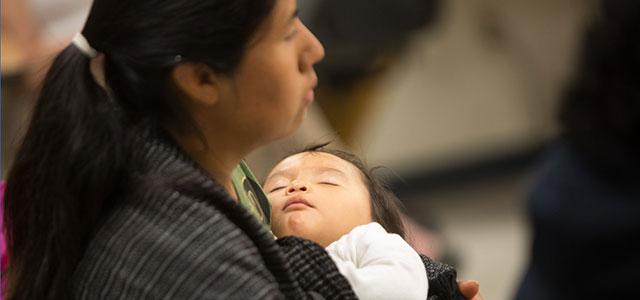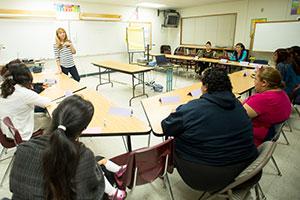
Mothers Across Borders
As a 7-year-old girl in El Salvador, Beatriz sold peanuts on the street with her mother to help feed their family.
When she became a mother herself, she didn’t want her children to have to worry about whether they would eat, go to school or have a chance for a better life. So she made the agonizing choice to leave her children and travel thousands of miles away, at one point crossing deserts and mountains on foot while trying to evade gangs and police. Her destination: the United States.
Beatriz looked to America as a place where she could earn enough money to improve her children’s quality of life. But in leaving, she didn’t know when she would see them again.
“When I left, my daughter said, ‘Mommy, please don’t leave,’” she recalled. “As I left, I turned around, and I saw both of my children waving good-bye.… That was four years ago.” She hasn’t seen her children since.
The brutal hardships Beatriz endured to find a better life for her family in America reads as though it comes from a distant time or place – a 19th-century immigrant’s sojourn or that of a refugee from a war-torn African nation – instead of from a woman we might see every day in a modern American community. But Beatriz was telling her story in 2009 to Rosa Maria Sternberg, an assistant adjunct professor in the Department of Family Health Care Nursing at UC San Francisco School of Nursing.
Transnational Mothers: A Contemporary Narrative
Beatriz is a “transnational mother,” Sternberg explains. Undocumented Latina immigrants like Beatriz come to the United States to work as maids, as nannies and in other low-wage jobs. Their experiences, which also include dangerous US-Mexico border crossings, form a dark and under-reported chapter in America’s contemporary immigration narrative.
The plight of Beatriz – and seven other women from El Salvador, Guatemala, Honduras and Mexico – was the subject of Sternberg’s doctoral dissertation at Florida Atlantic University. It also remains the cornerstone of her research work at UC San Francisco, which focuses on how to address the mental health challenges of Latina immigrant women.
“Leaving their children behind takes such a human toll on these women,” Sternberg says. “From the US point of view, it almost makes no sense that they could leave their children behind. But for them, they feel they have no choice. Those were the cards they were dealt. All of them said, ‘We’re mothers. We sacrifice.’”
As a nurse developing community-based mental health outreach services, Sternberg continues to encounter these women. The same is no doubt true for other nurses and professionals working in community-based care. These immigrant women live with high levels of stress and anxiety, and Sternberg hopes her research provides the context to help professionals provide culturally specific and evidence-based health care.
A Global Phenomenon
 Rosa Maria Sternberg (photos by Elisabeth Fall) As Sternberg delved into transnational mothering, she learned that the issue isn’t unique among US immigrants from Mexico and Central America. In fact, it’s a worldwide trend that reflects changing immigration patterns over the past half century. With 214 million people – or 3 percent of the world’s population – living outside their country of origin, women now constitute half of all international immigrants, according to the United Nations Population Fund.
Rosa Maria Sternberg (photos by Elisabeth Fall) As Sternberg delved into transnational mothering, she learned that the issue isn’t unique among US immigrants from Mexico and Central America. In fact, it’s a worldwide trend that reflects changing immigration patterns over the past half century. With 214 million people – or 3 percent of the world’s population – living outside their country of origin, women now constitute half of all international immigrants, according to the United Nations Population Fund.
In the United States, more women began to arrive after the passage of the Immigration and Nationality Act of 1965, which largely shifted the US to a system of family-based admissions, according to a Center for American Progress report. By the 1970s, the number of female immigrants surpassed the number of their male counterparts.
In today’s postindustrial landscape, women from poor regions of Central America, Eastern Europe and South and Southeast Asia immigrate to the United States, Canada and newly industrialized countries in the Middle East and take the jobs no one else wants.
These jobs may be low status, but the hundreds of millions of dollars these women send back home transforms the lives of their families and local economies. Their earnings feed, clothe and educate children, buy health care and improve living standards, according to a report on international female immigration by the United Nations Population Fund. Their earnings also contribute to a nearly half-trillion-dollar-a-year economy. The World Bank estimated that in 2013, remittances from all migrant workers to the developing world amounted to about $414 billion.
A common thread in the story of female immigration is the emergence of transnational families. However, as Sternberg found, the literature and data on transnational mothering are sparse.
What is known is that transnational families are nothing new. Just a few decades ago, fathers were usually the parents who migrated to other countries in search of economic opportunities. Now, a growing number of women are joining their husbands abroad. Or these women are the heads of their households and leave their young children behind in the care of older siblings or grandparents and other relatives.
A Personal Connection
Sternberg admits she was ignorant about transnational mothering until she started meeting these women herself. In the 1990s, Sternberg was living in South Florida, raising three children and completing her nursing studies while she and her then husband operated several preschools in communities around Fort Lauderdale.
Some of the nannies working for Sternberg’s affluent clients started talking to her when they came to pick up or drop off their charges. Sternberg soon learned these women were mothers themselves, but their children were far away, in Mexico or Central America.
“This was how I really became aware of this phenomenon and how prevalent it was,” she says. “It wasn’t easy for these women to talk about having children back home. They were afraid of the consequences, that they would be judged.”
Far from judging these women, Sternberg had things in common with them.
She herself is an immigrant, as well as the child of immigrants who felt they had no choice but to leave their home country. Her parents were refugees from the Spanish Civil War who settled in Chile. At 20, Sternberg moved to the United States alone, without knowing much English. While she planned to begin her nursing studies, she also wanted to escape the repressive regime of President Augusto Pinochet.
Over the years, she settled into life in the United States, but she never got over that “feeling that you don’t really belong anywhere.” She describes it as “an identity crisis that doesn’t really go away.” She also never saw her father again.
Sternberg eventually obtained her bachelor’s and master’s degrees at Florida Atlantic University. When it came time to pursue her doctorate, she thought of the nannies she met through her preschools. She also met transnational mothers while volunteering at a free community clinic in South Florida.
“Being a mother myself, I couldn’t imagine how they were able to come here and make the sacrifices they did,” she says.
True Stories
For her study, Sternberg detailed the experiences of eight women, ages 21 to 39. Their children ranged in age from 2 months to 24 years. They had been away from their children for anywhere from one to 13 years, and some had subsequently started new families in the United States.
“When I hear and read the stories from her doctoral work, it brings tears to my eyes and my heart,” says Kathryn Lee, a professor and associate dean for research in the School of Nursing.
Sternberg’s doctoral research has the richness of qualitative data and, as Lee points out, “The data are so moving and convey a lot more than numbers ever could.”
Like Beatriz, all of Sternberg’s sources reported living in extreme poverty and cited it as the number one reason they came to the United States. In Mexico, Margarita said, “We had nothing. There was no electricity or running water…just the river. We had to bring water on donkeys.”
Some also left to escape domestic violence. Margarita’s husband regularly beat her, locked her up and isolated her from her friends and family. “For many years, he hit me. He did not treat me well.”
Making the choice to leave their children and travel north was “distressing, heartbreaking, excruciating and agonizing,” the women told Sternberg.
Adding to their distress was the prospect of the border crossing, a trip that could take up to 25 days. All described enduring thirst and hunger while walking through the desert and climbing mountains day and night. “We suffer a lot,” said Consuelo. “We were so thirsty, and the coyotes [smugglers who guide immigrants across the border] did not bring enough water, so we drank dirty, sandy water.”
Margarita walked with a baby in her arms. “I was breastfeeding him. I was always ready to faint.”
Dolores came in a cargo train, but she was taken prisoner by gang members and sold for sex. “I was raped by all of them,” she said. Eventually, she escaped her kidnappers with the help of a local church and made her way to Florida.
Doing the Right Thing
Despite the dangers, the women still believed they were doing the right thing.
“We had to cross so many mountains,” Beatriz said. “I hurt my foot and had to drag myself. It was hard and I was in so much pain.… When I felt like giving up, I thought about my children. I was fighting for my children.”
Since coming to the United States, the women told Sternberg about living in fear of being caught and deported by US immigration authorities, so they tried to keep a low profile by not “integrating” into their communities.
As for their children, they said cell phones and calling cards helped them stay in regular contact, sometimes daily. They were proud that the money they sent home allowed their children to eat, sleep on mattresses or go to school. When asked if she ever considered returning home, Beatriz said, “If I go back, no one eats.”
The separation took its toll on Beatriz and the others. “Not seeing my children for four years makes me so sad,” she said. “I cry all the time.… I need to touch them…to smell them…to feel them. It is tearing my heart.”
Returning home for visits was out of the question. They hoped to one day reunite with their children for good, either by returning home or bringing their children to live in the United States.
Still, the women worried about how the distance would affect those reunifications. This was especially true of women who left behind young children. They didn’t know if their children would recognize them. “Every moment that I speak to them, I remind them that I am their mother, so that they don’t forget,” said Maria. “I tell them that they have to love me because I love them very much and they are the most important thing to me.”
The Implications of Transnational Mothering
 Sternberg leads a parent education class for immigrant mothers. Some of the women said the challenge of moving to a new country and adopting new cultural traditions helped them to become more assertive and independent. They also found meaning in sacrificing for their children.
Sternberg leads a parent education class for immigrant mothers. Some of the women said the challenge of moving to a new country and adopting new cultural traditions helped them to become more assertive and independent. They also found meaning in sacrificing for their children.
Nevertheless, some still suffered from the emotional trauma of crossing the border. Working long hours in low-paying jobs and missing their children had also taken a psychological and physical toll.
Sternberg has kept these women’s experiences in mind as she has embarked on related research.
With Lee, she worked on a 2013 quantitative study about depressive symptoms in midlife Latinas. With the School of Nursing’s Institute for Health & Aging, Sternberg developed an instrument to assess immigration stress, and is now developing a program to train 12 promotoras, or lay community members, to provide basic mental health services to 50 women and men in the Monument Corridor, a neighborhood in the Bay Area city of Concord. This neighborhood has a high population of Hispanic immigrants.
This past year, Sternberg has provided volunteer parent education classes to immigrant mothers at a public elementary school in the neighborhood. Some of the mothers in this parenting class have children in two countries. Their older children are back in Mexico or Central America; their younger children, who were born in the United States, are students at the school.
During a recent class, Sternberg engaged women in a conversation about raising children to have a strong sense of self-worth. These mothers may be isolated from mainstream American culture, but they want to do their best to help their children become confident and capable members of this society. “It’s so important for them to have this information as their children get older,” she says.
Knowing these women’s backgrounds and vulnerability for isolation, anxiety and depression, Sternberg understands that self-esteem may not be an easy quality for these women to pass on. She hopes this kind of understanding will be useful to other health care providers, social workers, educators and policymakers working with immigrant populations.
“Health care providers can advocate for Latina transnational mothers whose experiences may transcend beyond their own health and impact the health of their families and children here in the US,” Sternberg says. “Latina transnational motherhood is a hidden aspect of the human cost in the current reality of immigration in the US.”



